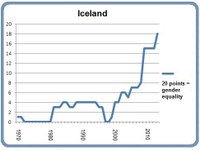Nordic women have gained a little more power since last year.
Document Actions
Document Actions

A new female Minister of Finance in 2012 gave extra points to Iceland, which was already top of the Nordic countries with 18 points. That is only two points away from complete gender equality.

Thanks to a female Prime Minister and head of state, as well as many female government ministers, Denmark gets many points and is only one point behind Iceland.

Wanja Lundby-Wedin’s retirement from the top LO job lost Sweden four female points.

A government reshuffle meant a new female Minister of Justice - yet at the same time a man took over as Minister of Social affairs. The result was no change in points for Norway.

Gender equality in positions of power has fallen fast in Finland as both the posts of prime minister and president went from being held by women to being held by men.
50 percent female government minister representation might look like gender equality has been accomplished. But it also depends on which positions are being held by women.
We have distributed 200 points - 40 for each Nordic country. 100 female points equals full gender equality.
We have looked at 13 government minister posts. Each gives one point except prime minister (5), finance minister (3) and foreign minister (2).
We have also included leaders of the largest trade unions and employers' organisations:
Leaders of confederations of trade unions (4), leaders of service industries unions (2), leaders of trade unions for academics (2), leaders of employers' organisations (2) and managing directors at employers' organisations (2).
And finally six important symbolic positions:
Heads of state, supreme court presidents, heads of central banks, arch bishops, police commissioners and commander-in-chief.
Heads of state get three points, while the others get one each. We have not included leaders of major companies because they are not considered to be employed as a result of a democratic process.
This year we have only been looking at who held the positions on 8 March each year.
Download the list here: Nordic Women in power in the Nordic region 1970-2013